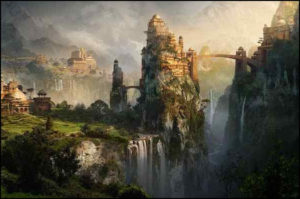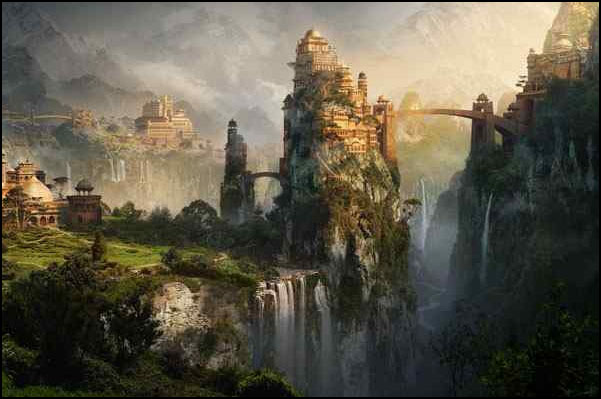The Kingdom of Shambhala
If you want to save the world, you’re not alone.
 I still believe
I still believe
we are capable of attention,
that anyone who notices the world
must want to save it.
From Testimony, by Poet, Rebecca Baggett
Several years ago I attended a live tele-cast in Telluride of the Bioneers’ conference. Paul Hawkens spoke with refreshing optimism about building a sustainable society. Through much of his talk, a video scrolled in the background listing the names of over 130,000 organizations worldwide dedicated to social and environmental justice. He noted that each organizational name represented anywhere from dozens to many thousands of dedicated staff, volunteers, and donors…people who believe in a hopeful future enough to work towards it. Further, he said the list was hardly complete and that if all groups could be known, it would probably exceed 500,000. And that was 8 years ago. As the names scrolled, Hawkens declared,
What you see is your kin. And to give you a sense of how big this movement is…if I had started this tape on Friday morning at 9 AM when this conference began, and if we sat here all day Friday, all night Friday, all day Saturday, all night Saturday, all day Sunday, all night tonight, and all day Monday, we still would not have seen the names of all the groups in the world…who we are.
Watch here from YouTube this powerful moment in Hawken’s talk.
No, we who would heal ourselves and our world are definitely not alone!
Years ago I discovered a lovely and inspiring story by Joanna Macy, engaged Buddhist author and activist. I’ve kept it handy now for many years, re-reading and sharing it from time to time. I just received permission from her to share it with you here. Perhaps it will inspire you to join the ranks of the “Shambhala Warriors”, or to realize that you already joined long ago.
I often tell this story in workshops, for it describes the work we aim to do and the training we engage in. It is from a prophecy that arose in Tibetan Buddhism over 12 centuries ago. I learned of it from my Tibetan friends in India when, in 1980, I heard many of them speaking of this ancient prophecy as coming true in our time period. The signs it foretold, they said, are recognizable now, in our generation. Since this prophecy speaks of a time of great danger – of apocalypse – I was, as you can imagine, very interested to find out about it.
There are varying interpretations of this prophecy. Some portray the coming of the kingdom of Shambhala as an internal event, a metaphor for one’s inner spiritual journey, independent of the world around us. Others present it as an entirely external event that will unfold in our world independent of what we may choose to do or what our participation may be in the healing of our world. A third version of the prophecy was given to me by my friend and teacher Choegyal Rinpoche of the Tashi Jong community in northern India.
There comes a time when all life on Earth is in danger. In this era, great barbarian powers have arisen. One is in the western hemisphere and one in the center of the Eurasian landmass. Although these two powers have spent their wealth in preparing to annihilate each other, they have much in common: weapons of unfathomable destructive power, and technologies that lay waste our world. In this era, when the whole future of sentient life seems to hang by the frailest of threads, the kingdom of Shambhala begins to emerge.
You can’t go there for it is not a place, it is not a geo-political entity. It exists in the hearts and minds of the Shambhala warriors – that is the term that Choegyal used, “warriors.” Nor can you recognize a Shambhala warrior when you see her or him, for they wear no uniform or insignia and they carry no banners. They have no barricades on which to climb to threaten the enemy, or behind which they can hide to rest or regroup. They do not even have any home turf. Always they must move on the terrain of the barbarians themselves.
Now the time comes when great courage – moral and physical – is required of the Shambhala warriors, for they must go into the very heart of the barbarian power, into the pits and pockets and citadels where the weapons are kept to dismantle them. To dismantle weapons, in every sense of the word, they must go into the corridors of power where decisions are made.
The Shambhala warriors have the courage to do this because they know that these weapons are manomaya. They are “mind-made.” Made by the human mind, they can be unmade by the human mind. The Shambhala warriors know the dangers that threaten life on Earth are not visited upon us by any extra-terrestial powers, satanic deities, or preordained evil fate. They arise from our own decisions, our own lifestyles, and our own relationships.
So in this time, the Shambhala warriors go into training. When Choegyal said this I asked, “How do they train?” They train, he said, in the use of two weapons. “What weapons?” I asked, and he held up his hands in the way the Lamas hold the ritual objects of bell and dorje in the Lama dance.
The weapons are compassion and insight. Both are necessary he said. You have to have compassion because it gives you the juice, the power, the passion to move. When you open to the pain of the world you move, you act. But that weapon by itself is not enough. It can burn you out, so you need the other – you need insight into the radical interdependence of all phenomena. With that wisdom you know that it is not a battle between good guys and bad guys, but that the line between good and evil runs through the landscape of every human heart. With insight into our profound inter-relatedness, you know that actions undertaken with pure intent have repercussions throughout the web of life, beyond what you can measure or discern. By itself, that insight may appear too cool, too conceptual, to sustain you and keep you moving, so you need the heat of the compassion. Together, within each Shambhala warrior and among the warriors themselves, these two can sustain us as agents of wholesome change. They are gifts for us to claim now in the healing of our world.
Reprinted by permission from World as Lover, World as Self by Joanna Macy, Parallax Press, Berkeley CA, 1991



